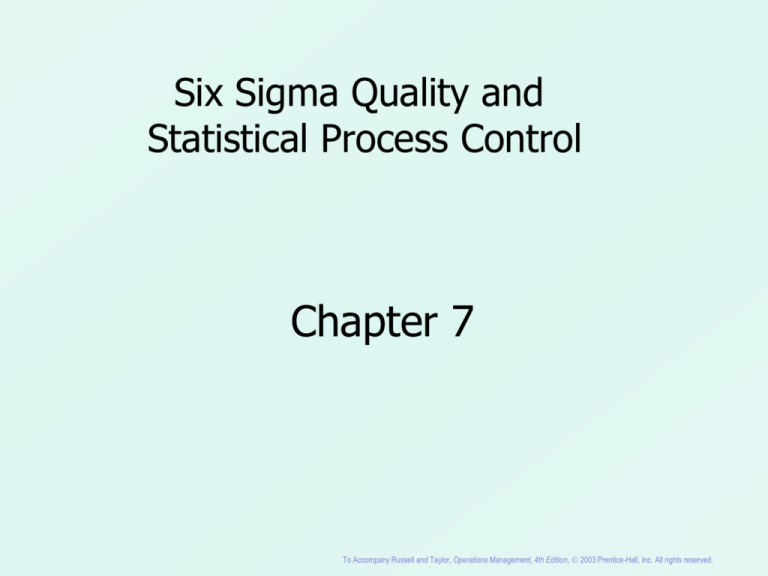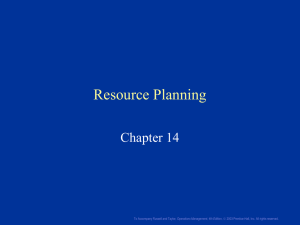
Six Sigma Quality and
Statistical Process Control
Chapter 7
1
To Accompany Russell and Taylor, Operations Management, 4th Edition, 2003 Prentice-Hall, Inc. All rights reserved.
Definition:
Total Quality Management
• Total Quality Management (TQ, QM or
TQM) and Six Sigma (6) are sweeping
“culture change” efforts to position a
company for greater customer
satisfaction, profitability and
competitiveness.
• TQ may be defined as managing the entire
organization so that it excels on all
dimensions of products and services that
are important to the customer.
To Accompany Russell and Taylor, Operations Management, 4th Edition, 2003 Prentice-Hall, Inc. All rights reserved.
Total Quality Is…
• Meeting Our Customer’s Requirements
• Doing Things Right the First Time; Freedom
from Failure (Defects)
• Consistency (Reduction in Variation)
• Continuous Improvement
• Quality in Everything We Do
3
To Accompany Russell and Taylor, Operations Management, 4th Edition, 2003 Prentice-Hall, Inc. All rights reserved.
The Continuous
Improvement Process
Empowerment/
Shared Leadership
Customer
Satisfaction
Business
Results
Team
Management
Process
Improvement/
Problem
Solving
Measurement
Measurement
Measurement
...
Measurement
To Accompany Russell and Taylor, Operations Management, 4th Edition, 2003 Prentice-Hall, Inc. All rights reserved.
4
Is 99% Quality Good
Enough?
• 22,000 checks will be deducted from
the wrong bank accounts in the next
60 minutes.
• 20,000 incorrect drug prescriptions
will be written in the next 12 months.
• 12 babies will be given to the wrong
parents each day.
5
To Accompany Russell and Taylor, Operations Management, 4th Edition, 2003 Prentice-Hall, Inc. All rights reserved.
Defects Per Million Opportunities (DPMO)
·
100K
But is Six Sigma Realistic?
·
IRS – Tax Advice (phone-in)
(66810 ppm)
10K
41
Average
Company
1K
31
····
···
Restaurant Bills
Doctor Prescription Writing
Payroll Processing
Order Write-up
Journal Vouchers
Wire Transfers
Air Line Baggage Handling
Purchased Material
Lot Reject Rate
100
21
·
(233 ppm)
10
11
Best in Class
1
1
Domestic Airline
Flight Fatality Rate
(3.4 ppm)
2
3
3
4
4
SIGMA
5
5
6
6
7
(0.43 ppm)
7
To Accompany Russell and Taylor, Operations Management, 4th Edition, 2003 Prentice-Hall, Inc. All rights reserved.
6
Six Sigma Quality
The objective of Six Sigma quality is 3.4
defects per million opportunities!
sigma level
1
2
3
4
5
6
6 with 1.5 stdev
mean shift
probability
0.84
0.977
0.9987
0.99997
0.9999997
0.99999999901
0.999996599
this is the amount
that exists to the left
OR the right of each total amount
tail (1-pr)
under the curve
0.158655259759
68.2689480%
0.022750062036
95.4499876%
0.001349967223
99.7300066%
0.000031686035
99.9936628%
0.000000287105
99.9999426%
0.000000000990
99.9999998%
0.000003400803
error rate
32 out of 100
4.6 out of 100
3 out of 1000
7 out of 100,000
6 out of 10,000,000
2 out of 1,000,000,000 (a billion)
99.9996599% 3.4 out of 1,000,000
7
To Accompany Russell and Taylor, Operations Management, 4th Edition, 2003 Prentice-Hall, Inc. All rights reserved.
Statistical Process
Control
• Take periodic samples from process
• Plot sample points on control chart
• Determine if process
UCL
is within limits
• Prevent quality
problems
LCL
8
To Accompany Russell and Taylor, Operations Management, 4th Edition, 2003 Prentice-Hall, Inc. All rights reserved.
Variation
Common Causes
Variation inherent in a process
Can be eliminated only through
improvements in the system
Special Causes
Variation due to identifiable factors
Can be modified through operator or
management action
9
To Accompany Russell and Taylor, Operations Management, 4th Edition, 2003 Prentice-Hall, Inc. All rights reserved.
Types of Data
Attribute data
Product characteristic
evaluated with a discrete choice
Good/bad, yes/no
Variable data
Product characteristic that
can be measured
Length, size, weight, height,
time, velocity
10
To Accompany Russell and Taylor, Operations Management, 4th Edition, 2003 Prentice-Hall, Inc. All rights reserved.
SPC Applied to
Services
Nature of defect is different in
services
Service defect is a failure to meet
customer requirements
Monitor times, customer
satisfaction
11
To Accompany Russell and Taylor, Operations Management, 4th Edition, 2003 Prentice-Hall, Inc. All rights reserved.
Service Quality Examples
Hospitals
Timeliness, responsiveness,
accuracy of lab tests
Grocery Stores
Check-out time, stocking, cleanliness
Airlines
Luggage handling, waiting times,
courtesy
Fast food restaurants
Waiting times, food quality,
cleanliness, employee courtesy
12
To Accompany Russell and Taylor, Operations Management, 4th Edition, 2003 Prentice-Hall, Inc. All rights reserved.
Service Quality Examples
Catalog-order companies
Order accuracy, operator
knowledge and courtesy,
packaging, delivery time,
phone order waiting time
Insurance companies
Billing accuracy, timeliness of claims
processing, agent availability and
response time
13
To Accompany Russell and Taylor, Operations Management, 4th Edition, 2003 Prentice-Hall, Inc. All rights reserved.
Control Charts
Graph establishing process control
limits
Charts for variables
Mean (x-bar), Range (R)
Chart for attributes
P Chart
C Chart
14
To Accompany Russell and Taylor, Operations Management, 4th Edition, 2003 Prentice-Hall, Inc. All rights reserved.
Process Control Chart
Out of control
Upper
control
limit
Process
average
Lower
control
limit
1
Figure 15.1
2
3
4
5
6
Sample number
7
8
9
10
15
To Accompany Russell and Taylor, Operations Management, 4th Edition, 2003 Prentice-Hall, Inc. All rights reserved.
A Process is In Control if
1. No sample points outside limits
2. Most points near process average
3. About equal number of points
above & below centerline
4. Points appear randomly
distributed
16
To Accompany Russell and Taylor, Operations Management, 4th Edition, 2003 Prentice-Hall, Inc. All rights reserved.
Development of
Control Chart
Based on in-control data
If non-random causes present,
find the special cause and
discard data
Correct control chart limits
17
To Accompany Russell and Taylor, Operations Management, 4th Edition, 2003 Prentice-Hall, Inc. All rights reserved.
Control Chart for
Attributes
p Charts
Calculate percent defectives in sample
18
To Accompany Russell and Taylor, Operations Management, 4th Edition, 2003 Prentice-Hall, Inc. All rights reserved.
p-Chart
UCL = p + zp
LCL = p - zp
where
z = the number of standard deviations from
the process average
p = the sample proportion defective; an
estimate of the process average
p = the standard deviation of the sample
proportion
p =
p(1 - p)
n
19
To Accompany Russell and Taylor, Operations Management, 4th Edition, 2003 Prentice-Hall, Inc. All rights reserved.
The Normal Distribution
95%
99.74%
-3
-2
-1
=0
1
2
3
20
To Accompany Russell and Taylor, Operations Management, 4th Edition, 2003 Prentice-Hall, Inc. All rights reserved.
Control Chart Z Values
Smaller Z values make more
sensitive charts
Z = 3.00 is standard
Compromise between sensitivity
and errors
21
To Accompany Russell and Taylor, Operations Management, 4th Edition, 2003 Prentice-Hall, Inc. All rights reserved.
p-Chart Example
20 samples of 100 pairs of jeans
SAMPLE
1
2
3
:
:
20
Example 15.1
NUMBER OF
DEFECTIVES
PROPORTION
DEFECTIVE
6
0
4
:
:
18
200
.06
.00
.04
:
:
.18
22
To Accompany Russell and Taylor, Operations Management, 4th Edition, 2003 Prentice-Hall, Inc. All rights reserved.
p-Chart Example
20 samples of 100 pairs of jeans
SAMPLE
1
2
3
:
:
20
Example 15.1
NUMBER OF
DEFECTIVES
6
0
4
:
:
18
200
PROPORTION
DEFECTIVE
.06
.00
total defectives
p = .04
total sample observations
:
= 200: / 20(100)
= 0.10
.18
23
To Accompany Russell and Taylor, Operations Management, 4th Edition, 2003 Prentice-Hall, Inc. All rights reserved.
p-Chart Example
20 samples of 100 pairs of jeans
SAMPLE
1
2
3
:
:
20
Example 15.1
NUMBER OF
DEFECTIVES
PROPORTION
DEFECTIVE
p = 0.10
6
.06
0
0.10(1 - 0.10)
p(1.00
- p)
UCL = p + z
= 0.10 + 3
100
n
4
.04
:
UCL := 0.190
:
0.10(1 - 0.10)
p(1 - p):
LCL
= 0.10 - 3
18= p - z
100
n.18
200= 0.010
LCL
24
To Accompany Russell and Taylor, Operations Management, 4th Edition, 2003 Prentice-Hall, Inc. All rights reserved.
p-Chart
0.20
UCL = 0.190
0.18
0.16
Proportion defective
0.14
0.12
0.10
p = 0.10
0.08
0.06
0.04
0.02
LCL = 0.010
2
4
6
8
10
12
Sample number
14
16
18
20
25
To Accompany Russell and Taylor, Operations Management, 4th Edition, 2003 Prentice-Hall, Inc. All rights reserved.
C Chart
• Used when you can’t calculate a
proportion defective and an actual
count is used.
• Key –the number of defects is
assumed to come from a large
population
• Ex. Defects in the paint job of a car
26
To Accompany Russell and Taylor, Operations Management, 4th Edition, 2003 Prentice-Hall, Inc. All rights reserved.
C Chart con’t
• The mean is the average counted
number of defects per item (total
divided number of samples
• The sample standard deviation is
√cbar (square root of the mean of C)
27
To Accompany Russell and Taylor, Operations Management, 4th Edition, 2003 Prentice-Hall, Inc. All rights reserved.
Control Charts for
Variables
Mean chart ( x -Chart )
Uses average of a sample
Range chart ( R-Chart )
Uses amount of dispersion in
a sample
28
To Accompany Russell and Taylor, Operations Management, 4th Edition, 2003 Prentice-Hall, Inc. All rights reserved.
Range ( R- ) Chart
UCL = D4R
LCL = D3R
R
R= k
where
R = range of each sample
k = number of samples
29
To Accompany Russell and Taylor, Operations Management, 4th Edition, 2003 Prentice-Hall, Inc. All rights reserved.
SAMPLE SIZE
n
FACTOR FOR x-CHART
A2
2
3
4
5
6
7
8
9
10
11
12
13
14
15
16
17
18
19
20
1.88
1.02
0.73
0.58
0.48
0.42
0.37
0.44
0.11
0.99
0.77
0.55
0.44
0.22
0.11
0.00
0.99
0.99
0.88
FACTORS FOR R-CHART
D3
D4
Range ( R- ) Chart
Table 15.1
0.00
0.00
0.00
0.00
0.00
0.08
0.14
0.18
0.22
0.26
0.28
0.31
0.33
0.35
0.36
0.38
0.39
0.40
0.41
3.27
2.57
2.28
2.11
2.00
1.92
1.86
1.82
1.78
1.74
1.72
1.69
1.67
1.65
1.64
1.62
1.61
1.61
1.59
30
To Accompany Russell and Taylor, Operations Management, 4th Edition, 2003 Prentice-Hall, Inc. All rights reserved.
R-Chart Example
OBSERVATIONS (SLIP-RING DIAMETER, CM)
SAMPLE k
1
2
3
4
5
x
R
1
2
3
4
5
6
7
8
9
10
5.02
5.01
4.99
5.03
4.95
4.97
5.05
5.09
5.14
5.01
5.01
5.03
5.00
4.91
4.92
5.06
5.01
5.10
5.10
4.98
4.94
5.07
4.93
5.01
5.03
5.06
5.10
5.00
4.99
5.08
4.99
4.95
4.92
4.98
5.05
4.96
4.96
4.99
5.08
5.07
4.96
4.96
4.99
4.89
5.01
5.03
4.99
5.08
5.09
4.99
4.98
5.00
4.97
4.96
4.99
5.01
5.02
5.05
5.08
5.03
0.08
0.12
0.08
0.14
0.13
0.10
0.14
0.11
0.15
0.10
50.09
1.15
Example 15.3
31
To Accompany Russell and Taylor, Operations Management, 4th Edition, 2003 Prentice-Hall, Inc. All rights reserved.
R-Chart Example
UCL = D4R = 2.11(0.115) = 0.243
R
1.15
R=
=
= 0.115
OBSERVATIONS
(SLIP-RING
DIAMETER, CM)
k
10
LCL = D
3R = 0(0.115) = 0
SAMPLE0.28
k –
1
2
3
4
5
x
R
Range
1
2
3
4
5
6
7
8
9
10
Example 15.3
0.24 –
0.20 –
0.16 –
0.12 –
0.08 –
0.04 –
0–
5.02 5.01 4.94
5.01
UCL 5.03
= 0.2435.07
4.99 5.00 4.93
5.03 4.91 5.01
0.115 5.03
4.95R =4.92
4.97 5.06 5.06
5.05 5.01 5.10
5.09 5.10 5.00
5.14 5.10 4.99
LCL = 0
5.01
|
| 4.98| 5.08
|
1
2
3
4.99
4.95
4.92
4.98
5.05
4.96
4.96
4.99
5.08
5.07
|
|
4.96
4.96
4.99
4.89
5.01
5.03
4.99
5.08
5.09
4.99|
4
5
6
7
Sample number
4.98 0.08
5.00 0.12
4.97 0.08
4.96 0.14
4.99 0.13
5.01 0.10
5.02 0.14
5.05 0.11
5.08 0.15
5.03
|
| 0.10|
50.09
8
91.1510
32
To Accompany Russell and Taylor, Operations Management, 4th Edition, 2003 Prentice-Hall, Inc. All rights reserved.
x-Chart Calculations
x1 + x2 + ... xk
=
x=
k
=
UCL = x + A2R
=
LCL = x - A2R
where
=
x = the average of the sample means
33
To Accompany Russell and Taylor, Operations Management, 4th Edition, 2003 Prentice-Hall, Inc. All rights reserved.
x-Chart Example
OBSERVATIONS (SLIP-RING DIAMETER, CM)
SAMPLE k
1
2
3
4
50.095.01 4.94 4.99
=1 x
5.02
x=
=
= 5.01 cm
k
2
5.01
10 5.03 5.07 4.95
5
x
R
4.96 4.98
4.96 5.00
3
4.99 5.00 4.93 4.92 4.99 4.97
4
5.03 4.91 5.01 4.98 4.89 4.96
=
UCL5 = x + A2R4.95
= 5.01
= 5.08
4.92+ (0.58)(0.115)
5.03 5.05 5.01
4.99
6
4.97 5.06 5.06 4.96 5.03 5.01
5.01- (0.58)(0.115)
5.10 4.96 4.99
5.02
LCL7 = x= - A2R5.05
= 5.01
= 4.94
8
5.09 5.10 5.00 4.99 5.08 5.05
9
5.14 5.10 4.99 5.08 5.09 5.08
10
5.01 4.98 5.08 5.07 4.99 5.03
0.08
0.12
0.08
0.14
0.13
0.10
0.14
0.11
0.15
0.10
50.09
1.15
Example 15.4
34
To Accompany Russell and Taylor, Operations Management, 4th Edition, 2003 Prentice-Hall, Inc. All rights reserved.
x-Chart Example
5.10 –
5.08 –
5.06 –
SAMPLE k
UCL = 5.08
OBSERVATIONS (SLIP-RING DIAMETER, CM)
1
2
3
4
5.04 – 50.09
=1 x
4.94 4.99
x=
= 5.02 5.01= 5.01
cm
k5.02 – 5.0110=5.03 5.07 4.95
2
5
x
Mean
4.96 4.98
4.96 5.00
= 5.01
3
4.99 x5.00
4.93 4.92 4.99 4.97
5.00 – 5.03 4.91
4
5.01 4.98 4.89 4.96
=
UCL5 = x +
A R = 5.01 + (0.58)(0.115)
= 5.08
5.03 5.05 5.01
4.99
4.98 –2 4.95 4.92
6
4.97 5.06 5.06 4.96 5.03 5.01
5.01- (0.58)(0.115)
5.10 4.96 4.99
5.02
LCL7 = x= -4.96
A2–R5.05
= 5.01
= 4.94
8
5.09 LCL
5.10
5.00 4.99 5.08 5.05
= 4.94
4.94 –
9
5.14 5.10 4.99 5.08 5.09 5.08
10
5.08 5.07 4.99 5.03
4.92 – 5.01 4.98
|
1
Example 15.4
|
2
|
3
|
|
|
|
4
5
6
7
Sample number
R
0.08
0.12
0.08
0.14
0.13
0.10
0.14
0.11
0.15
0.10
| 50.09
|
|1.15
8
9
10
35
To Accompany Russell and Taylor, Operations Management, 4th Edition, 2003 Prentice-Hall, Inc. All rights reserved.
Using x- and R-Charts
Together
Each measures the process
differently
Both process average and variability
must be in control
36
To Accompany Russell and Taylor, Operations Management, 4th Edition, 2003 Prentice-Hall, Inc. All rights reserved.
Sample Size Determination
Attribute control charts
50 to 100 parts in a sample
Variable control charts
2 to 10 parts in a sample
37
To Accompany Russell and Taylor, Operations Management, 4th Edition, 2003 Prentice-Hall, Inc. All rights reserved.
Process Capability
Process limits (The “Voice of the Process” or
The “Voice of the Data”) - based on natural
(common cause) variation
•
Tolerance limits (The “Voice of the Customer”)
– customer requirements
•
Process Capability – A measure of how
“capable” the process is to meet customer
requirements; compares process limits to
tolerance limits
•
Process Capability
Range of natural variability in process
Measured with control charts.
Process cannot meet specifications if
natural variability exceeds tolerances
3-sigma quality
Specifications equal the process control
limits.
6-sigma quality
Specifications twice as large as control
limits
39
To Accompany Russell and Taylor, Operations Management, 4th Edition, 2003 Prentice-Hall, Inc. All rights reserved.
Process Capability
Design
Specifications
(a) Natural variation
exceeds design
specifications; process
is not capable of
meeting specifications
all the time.
Process
Design
Specifications
(b) Design specifications
and natural variation the
same; process is capable
of meeting specifications
most the time.
Process
Figure 15.5
40
To Accompany Russell and Taylor, Operations Management, 4th Edition, 2003 Prentice-Hall, Inc. All rights reserved.
Process Capability
Design
Specifications
(c) Design specifications
greater than natural
variation; process is
capable of always
conforming to
specifications.
Process
Design
Specifications
(d) Specifications greater
than natural variation,
but process off center;
capable but some output
will not meet upper
specification.
Process
Figure 15.5
41
To Accompany Russell and Taylor, Operations Management, 4th Edition, 2003 Prentice-Hall, Inc. All rights reserved.
Process Capability
Measures
Process Capability Index
Cpk = minimum
=
x - lower specification limit
,
3
=
upper specification limit - x
3
42
To Accompany Russell and Taylor, Operations Management, 4th Edition, 2003 Prentice-Hall, Inc. All rights reserved.
Computing Cpk
Net weight specification = 9.0 oz 0.5 oz
Process mean = 8.80 oz
Process standard deviation = 0.12 oz
Cpk = minimum
= minimum
=
x - lower specification limit
,
3
=
upper specification limit - x
3
8.80 - 8.50 9.50 - 8.80
,
3(0.12)
3(0.12)
= 0.83
Example 15.7
43
To Accompany Russell and Taylor, Operations Management, 4th Edition, 2003 Prentice-Hall, Inc. All rights reserved.
Interpreting the Process
Capability Index
Cpk < 1
Not Capable
Cpk > 1
Capable at 3
Cpk > 1.33
Capable at 4
Cpk > 1.67
Capable at 5
Cpk > 2
Capable at 6








